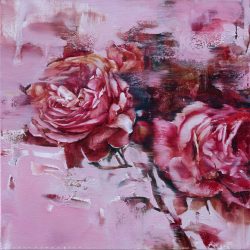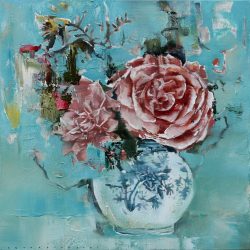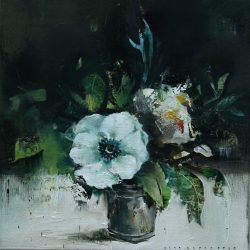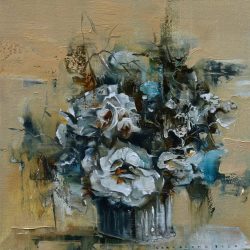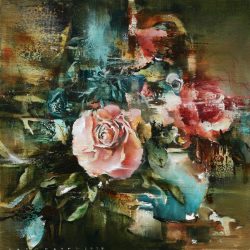TAN KENT KEONG 陳傑強
Tan Kent Keong born in 1979 in the state of Kedah, Malaysia, is an artist known for his profound emotional expression and unique style. He earned his Master of Fine Arts degree from the Graduate Institute of Fine Arts at National Taiwan University of Arts in 2013, and since then, his art has gained acclaim for its rich content and distinctive style.
Tan Kent Keong’s life and artistic career are marked by a quest for belonging and a deep sense of nostalgia. He frequently changes his place of residence, and this ever-changing life experience profoundly influences his artistic practice, infusing it with a sense of nostalgia. Adapting to different environments while bidding farewell to previous residences, he channels these emotions into his art.
In 2014, Tan Kent Keong made a significant decision to leave the bustling life of Taipei and transition to the rural setting of Fugang, Taiwan. This dramatic shift in his living environment represents his lonely venture into the unknown, contrasting sharply with his previous urban lifestyle. In the tranquility of the countryside, Tan Kent Keong began to reflect on the concept of the “box,” recognizing its prevalent existence in urban life.
Since 2008, Tan Kent Keong’s “Toy” series of works takes a nostalgic look back at childhood, exploring fundamental life questions such as “Who am I?” and “What kind of person am I?” His consciousness seems to be caught in an eternal vortex of disappearance yet repeated viewing, often needing to break down the walls of time to revisit past scenes and repeatedly peruse ordinary moments in life. In the midst of this, he asks himself what he can do. He deeply understands that the essence of creation always returns to his own experiences and insights into life, which he conveys through the portrayal of everyday objects.
His “Floral” series of works goes beyond the mere depiction of objects; it symbolizes these objects as representations of his inner emotional state, vividly conveying his sense of solitude. This “solitude” isn’t synonymous with “loneliness or emptiness”; rather, it allows him to find tranquility in the depths of his soul.
He references a line from the poem of Gong Zizhen, a Qing Dynasty philosopher: “Falling flowers are not heartless, they become spring mud to protect the flowers.” This line metaphorically captures his decision to resign from an official position and return to his hometown. Tan Kent Keong understands that, like falling flowers, his choices, while entailing sacrifices, are not without meaning; instead, they nurture hope for the future. His “Floral” series doesn’t merely depict individual flowers; instead, it encapsulates the various stages, from budding to blooming to withering, using techniques of transformation, haziness, speed, and montage to convey the multiple facets of flowers, mirroring his own experiences of life’s ups and downs, all the while carrying a sense of hope for rebirth.
In essence, Tan Kent Keong’s art not only conveys personal emotions and memories but also explores broader themes such as hometown, life’s narrative, and pivotal moments. His creative speed and acute observations infuse his works with vitality and depth, making him a prominent figure in the world of contemporary art.
陳傑強生於1979年,來自馬來西亞吉打州,是一位充滿深刻情感表達和獨特風格的藝術家。他於2013年獲得國立台灣藝術大學美術學系研究所的碩士學位,此後,他的藝術作品廣受讚譽,以其充實的內涵和獨具特色的風格而聞名於世。
陳傑強的生活和藝術生涯充滿了尋找歸屬感和深沉的懷舊情感。他經常改變居住地,這種不斷變遷的生活經歷深刻地影響了他的藝術實踐,使其充滿了懷舊之情。他在不同的環境中適應,同時告別以前的住所,將這些情感轉化為藝術表達。
2014年,陳傑強決定離開台北繁忙的生活,轉向台灣福港鄉村。這種生活環境的巨大改變代表了他對未知領域的孤獨嘗試,也與之前都市生活的鮮明對比。在鄉村寧靜中,陳傑強開始反思”盒子”的概念,並認識到這一概念在都市生活中的普遍存在。
自2008年開始,陳傑強在他的”玩具”系列作品中追懷那回不去的童年往事,我作為「我」,我是「誰」,意識如同掉進一個永遠消失卻一再被觀看的漩渦,似乎每次都要推倒時間的一堵牆,重返過去的場景,不斷翻閱生活裡的平凡。然後,他問自己,自己能做些什麼呢?他深刻認識到創作的本質總是要回歸到自己對生命的體驗和感悟,這就是對生活物件的詮釋。
他的”花卉”系列作品不僅僅是對物體的描繪,更像是將這些物體作為精神狀態的象徵,生動地表達了他內心的孤獨情感。這種”孤獨”並不等同於”寂寞或空虛”,相反,它讓他能夠在心靈的寧靜中找到安寧。
他引用了清朝思想家龔自珍的詩句:”落花不是無情物,化作春泥更護花。” 這句話比喻了自己辭去官職回鄉的決定,表達了他的情感。陳傑強理解,就像落下的花朵一樣,他的選擇雖然有所捨棄,但它們並不是毫無意義的,反而會為未來培育希望。他的花卉系列作品創作並非將單一花卉指涉進行描繪,而是將週期蘊藏含苞、綻放、凋零等狀態,以變形,朦朧,速度和蒙太奇手法讓畫面並存不同時期花的姿態,來借喻自身歷經人情世故,起伏更迭以後的我,依舊帶著重生的期盼。
陳傑強通過他的藝術作品,不僅表達了個人情感和回憶,還觸及了更廣泛的主題,如故鄉、生命劇碼和生命中的轉折。他的創作速度和敏銳觀察力使他的作品充滿了活力和深度。
-
萌之
Awakened Beauty
66x66cm(22)
Oil On Canvas
2020
-
朝曦
Dawn
59x59cm(17)
Oil On Canvas
2020
-
窺
A Silent Peep
45x45cm(10)
Oil On Canvas
2020
-
殷實
Prosperous
45x45cm(10)
Oil On Canvas
2020
-
SOLD
甚殷
Abundant Blossoms
65x65cm(21)
Oil On Canvas
2020
